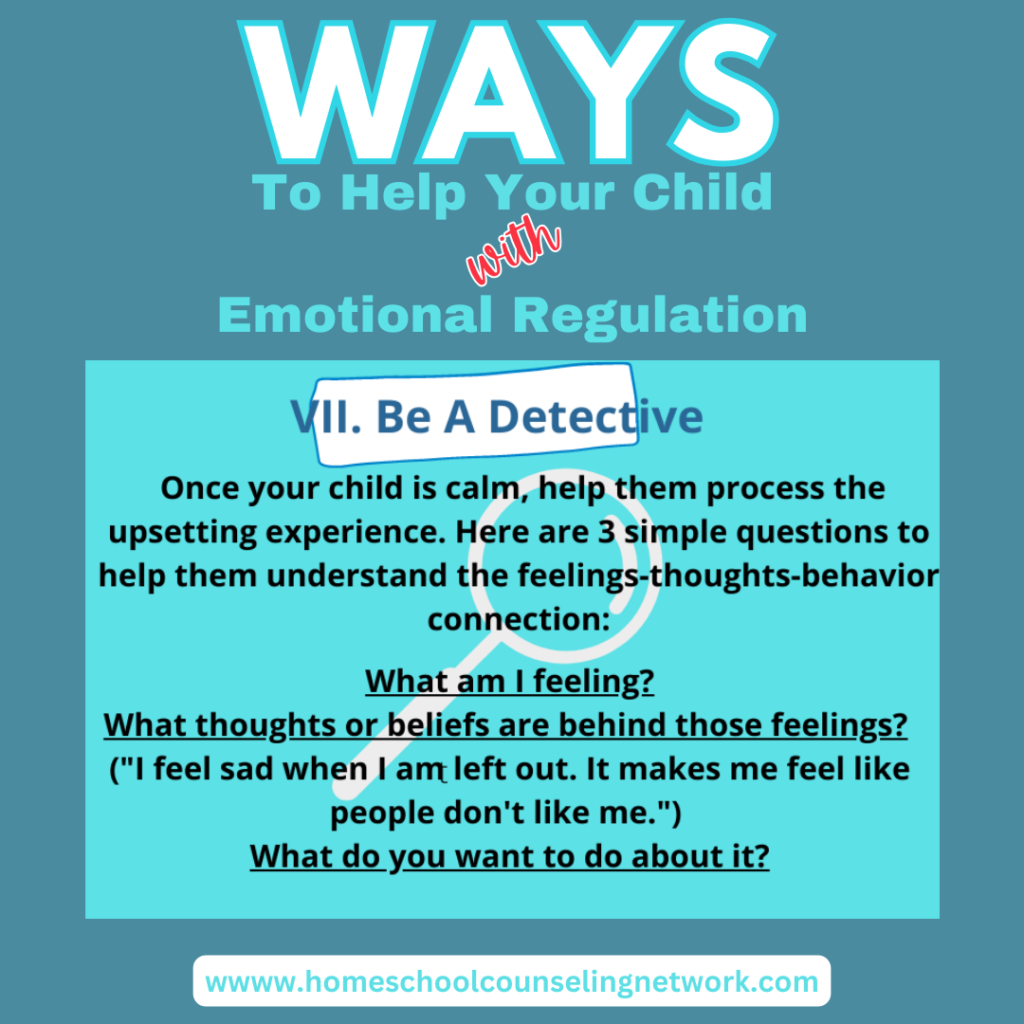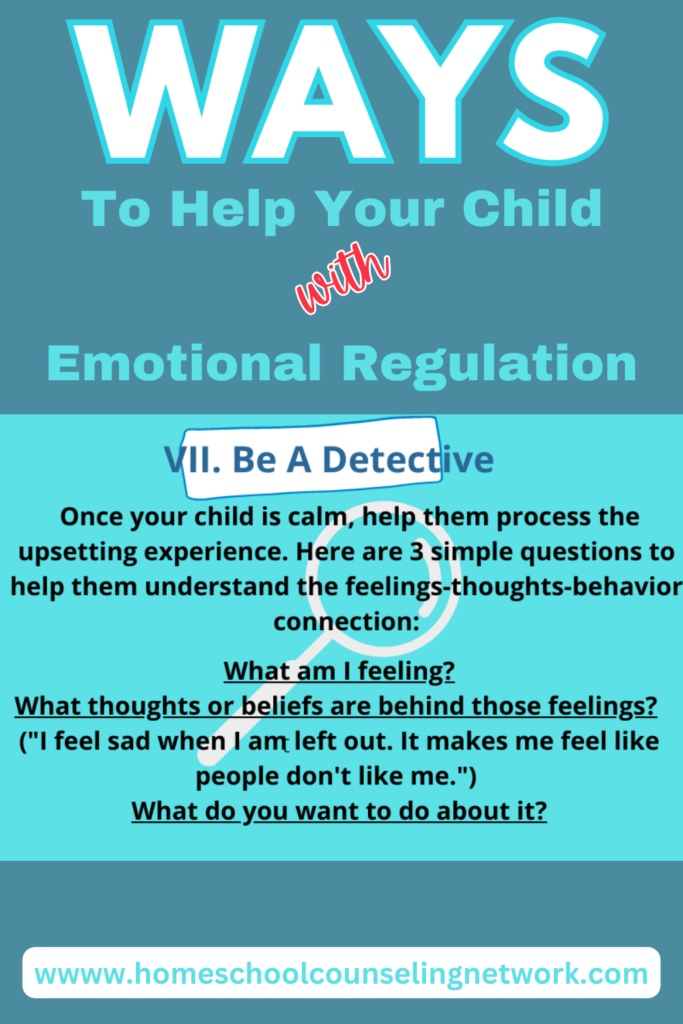Get To The Bottom of Tantrums By Playing Detective

Are you hanging in there? We’re in the home stretch now! We’ve made it to Tip # 7 in our Eight Ways To Help Your Child With Emotional Regulation, Playing Detective.
Super Sleuths
I love mysteries!
Whether it’s sleuthing with Sherlock Holmes in a novel, solving cases with Columbo, or figuring out a whodunit in the board game Clue after dinner as a family, I view cracking codes as exciting and challenging.
It was my love for the complex and unexpected that contributed to my former career as a therapist.
After all, what is more complex than the human behavior?

On The Case
All behavior has a purpose.
Learning how to engage your inner sleuth as a parent is beneficial in numerous ways. From improving both your and your child’s communication skills to building your child’s self-esteem to enhancing your bond with your child, taking the time to tease out the thoughts and feelings behind your child’s actions is a powerful tool.
But before we can tackle the task at hand, we must first separate ourselves and our child from the situation at hand. We accomplish this in a variety of ways.
Before you put on your detective’s cap, grab your pipe, and call for Watson, you must first take a time-out. Remember calming exercises we learned in earlier posts in the series (i.e., the Power of the Pause, cloud-watching, grounding exercises, deep-belly breathing, etc)?
Now is the time to put those into play. Only once you and your child are both calm will you be able to do a little detective work. Otherwise, your search for understanding can quickly sour.
Clues To Help Defuse
Now that we have made good use of our newly acquired calming exercises, we are ready to proceed. Remember you can always pull out any of these tools from your toolbox to help you or your child center yourself.
Once calm, the logical side of our brain (and our child’s brain) can power on and report for duty. After all, every good detective needs support to solve a case, right?
Have you ever noticed how the most successful detectives are not the ones who bully, pressure, or intimidate? No. They’re the ones who are charismatic, cool, calm, and confident. Please do not misunderstand. By no means am I suggesting we view our child’s behavior as criminal (if that is the case then you need to be reading an entirely different article).
Rather, we should remember that helping our child explore the thought-feeling-behavior connection should look like a conversation, not an interrogation.
Solving The Case
Now that you are ready for your tete-a-tete with your tot or teen, what do you ask?
Start with the feeling. Sometimes identifying thoughts takes a bit more exploration. Here are a few suggestions:
- What am I feeling?
- Use a feelings chart to help a child (i.e., feeling wheel, faces)
- Ask about physical symptoms (i.e., hungry, tired, hurt, sad, angry, annoyed)
Next, talk with your child about any thoughts they may have about those feelings or the situation that preceded the outburst.
- Older children and teens may be able to explore their thoughts more easily, while younger children may need more assistance
- Use statement format: “I feel _________ when ________ happens.” (Ex: I feel sad when I am left out. It makes me feel like people don’t like me.”
Empower your child with choice:
- What do you want to do about it?
- Some children may need suggestions of possible choices with subsequent outcomes (help them list – see The Power of the Pause post for a refresher on reacting versus responding)
- Either way, there is power in choice. Consequences, positive or negative, always come with choice. Help your children own theirs.
Keep it brief.
- Remember, this is a conversation, not a therapy session.
- If need be, set a timer for 5 minutes to help.
- Keep it casual. For young children, chatting while playing is often useful. After all, play is a language all on its own. For older children and teens, chat while engaged in activities together like making dinner or folding laundry. Maybe take it outside and shoot a few hoops, pull weeds, or go for a walk.
We all have a desire to be heard. Children are no different from adults in this aspect. Validation reassures us that we matter. Even when receiving unpleasant feedback, having our feelings acknowledged (feelings, not bad behavior) can help us be more receptive to how we need to act differently. After all, the ultimate goal is a healthy relationship.
Coming Up
Feeling more confident? I hope so. We’ve almost made it to the end of our Eight Ways To Help Your Child With Emotional Regulation series. Be sure you do not miss the final post where we pause for reflection, self-reflection, and reflection of feelings. Grab your mirrors and come learn how to help your child manage BIG feelings with a Mirror Exercise.
Keep In Touch
Be sure you do not miss a blog post by signing up for our email list, liking our Facebook, Instagram, Linked In, or Pinterest pages, or subscribing to our YouTube channel.
Like what you see here? Sharing is caring!
Blessings,
Kimberly Bennett, LPC
Founder/CEO It’s Only Homeschooling
Founder/CEO The Homeschool Counseling Network

This website is not a professional counseling website and nothing here should be construed as professional counseling advice. Although Kimberly Bennett, LPC is a Licensed Professional Counselor, she is not your counselor, and no counselor-client relationship is established unless she has signed an agreement with you. All information provided through this website is for informational and educational purposes only.